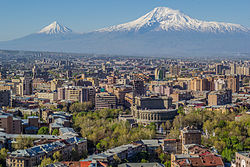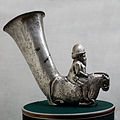Yerevan
Yerevan (Armenian: Երեւան or Երևան) is the capital and largest city of Armenia. In 2004 about 1,088,300 people lived in Yerevan. Some people write Yerevan as Erevan. In past, Yerevan was called Erebuni or Erivan.
Capital city | |
 | |
| Coordinates: 40°10′53″N 44°30′52″E / 40.18139°N 44.51444°E | |
| Country | |
| Administrative Districts | 12 |
| Founded as Erebuni | 782 BC[1] |
| Founded by | Argishti I of Urartu |
| Government | |
| • Mayor | Tigran Avinyan[2] |
| Area | |
| • Total | 223 km2 (86 sq mi) |
| Population (2020)[3] | |
| • Total | 1,084,000 |
| • Density | 4,861/km2 (12,590/sq mi) |
It is on the Hrazdan River, and is the administrative, cultural, and industrial center of the country.
The history of Yerevan dates back to the 8th century BC, with the founding of the Urartian fortress of Erebuni in 782 BC.[4] Eventually, the letter "b" in the name Erebuni changed in the 5th or 4th century BC, becoming "v".[5]
Climate
The climate of Yerevan is continental, with dry, hot summers and cold, snowy and short winters. The temperature in August can reach 40°C (104°F), while January may be as cold as -15 °C (5 °F). The amount of precipitation is small, amounting annually to about 350 mm (14 in).
Culture
As a centre of Armenian culture, Yerevan is the site of Yerevan State University (1919), the Armenian Academy of Sciences, a historical museum, an opera house, a music conservatory and several technical institutes. The Matenadaran archives hold a rich collection of valuable ancient Armenian, Greek, Assyrian, Hebrew, Roman and Persian manuscripts. Yerevan has several large public libraries, a number of museums and theaters, botanical gardens and zoos. It is also at the heart of an extensive rail network and is a major trading centre for agricultural products. In addition, industries in the city produce metals, machine tools, electrical equipment, chemicals, textiles and food products.
Two major tourist attractions are the Opera House, the ruins of an Urartu fortress and a Roman fortress. The Armenia Marriott Hotel is in the heart of the city at Republic Square (also known as Hraparak).
Metro
The Yerevan Metro is a rapid transit system that serves the capital city. Its interior resembles that of western former Soviet nations with chandeliers hanging from the corridors. The metro stations had most of their names changed after the collapse of the Soviet Union and the Independence of the Republic of Armenia.
Economy
Yerevan is Armenia's industrial, transportation, and cultural center. Manufactures include chemicals, primary metals, machinery, rubber products, plastics, textiles, and processed food. Not only is Yerevan the headquarters of major Armenian companies, but of international ones as well, as it's seen as an attractive outsourcing location for Western European, Russian and American multinationals.
Development
Recently, Yerevan has been undergoing an ambitious redevelopment process in which old Soviet-style apartments and buildings are being demolished and replaced with modern buildings. However, this urban renewal plan has been met with opposition and ([1] Archived 2010-08-12 at the Wayback Machine) criticism from some residents.
Yerevan Media
The "birth certificate" of Yerevan at the Erebuni Fortress—a cuneiform inscription left by King Argishti I of Urartu on a basalt stone slab about the foundation of the city in 782 BCE
"YEREVAN" (ԵՐԵՒԱՆ) in an inscription from Kecharis, dating back to 1223
Mount Ararat, the national symbol of Armenia, dominates the Yerevan skyline.
Foundations of Shengavit historical site (site settled 3200 BC cal to 2500 BC cal)
Painting showing the founding of Yerevan by Argishti I in 782 BC (Erebuni Museum)
Erebuni Fortress, founded by King Argishti I in 782 BC
Foundations of Teishebaini building commenced in mid-7th century BC
Achaemenid rhyton from Erebuni
Katoghike Tsiranavor Church of Avan, 6th century
References
- Sergey Vardanyan 1995. The capitals of Armenia. Apolo. ISBN 5-8079-0778-7
- G. Zakoyan, M. Sivaslian, V. Navasardian 2001. My Yerevan. Acnalis. ISBN 99930-902-0-4
Other websites
| Wikimedia Commons has media related to Lua error in Module:Commons_link at line 62: attempt to index field 'wikibase' (a nil value).. |
- Yerevan Municipality webpage in Armenian and English
- Yerevan.ru - The capital of Armenia online (Russian)
- Erebuni History and excavation description, edited by Rick Ney
- - Online News From Armenia. Edited by John Hughes. Archived 2008-05-16 at the Wayback Machine
- Yerevan article on Armeniapedia
- Yerevan article on Cilicia.com Archived 2005-02-09 at the Wayback Machine
- Armenia Info Yerevan page Archived 2016-11-15 at the Wayback Machine
- The Yerevan Metro system
- Interactive CD - Yerevan Virtual
Related pages
| Wikimedia Commons has media related to Lua error in Module:Commons_link at line 62: attempt to index field 'wikibase' (a nil value).. |











